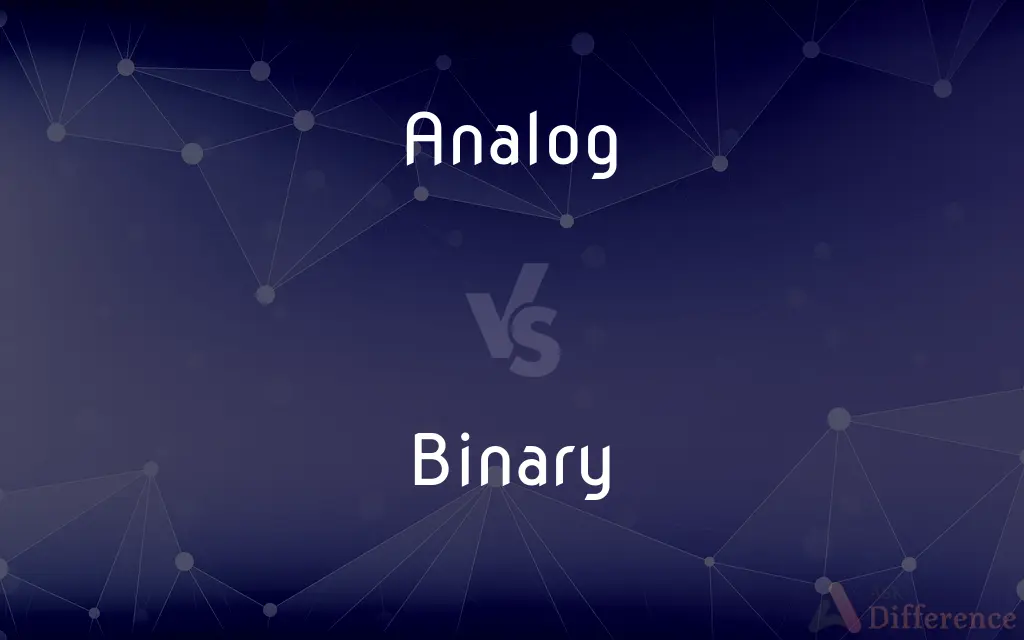Analog vs. Binary — What's the Difference?
By Fiza Rafique & Urooj Arif — Updated on April 23, 2024
Analog signals represent data as continuous waves, capturing gradations in information, whereas binary signals use discrete 0s and 1s, ideal for digital technology.

Difference Between Analog and Binary
Table of Contents
ADVERTISEMENT
Key Differences
Analog signals are continuous, varying smoothly over time, which makes them ideal for representing audio and video in natural forms. On the other hand, binary signals are discontinuous, consisting only of two states: 0 and 1, which simplifies processing and storage in digital systems.
In analog technology, information is encoded as a waveform that directly correlates with the original signal. Whereas in binary, information is represented as sequences of bits, which are interpreted by devices to reconstruct the original data.
Analog systems are more susceptible to noise and degradation over distance, as slight variations in the signal can introduce errors. Conversely, binary signals are more robust against noise, since only significant disturbances can alter the state of the bits from 0 to 1 or vice versa.
The resolution in analog signals is theoretically infinite, as they provide a smooth and continuous representation. In contrast, binary signals have a fixed resolution determined by the number of bits used, which limits the fineness of the data representation.
Analog devices are generally harder to integrate with modern digital technology, which primarily operates on binary logic. On the other hand, binary systems are inherently compatible with digital computers and networks, facilitating easier integration and automation.
ADVERTISEMENT
Comparison Chart
Nature
Continuous
Discrete
Representation
Waveforms
Sequences of 0s and 1s
Susceptibility to Noise
High
Low
Integration
Complex with digital tech
Seamless with digital tech
Resolution
Theoretically infinite
Limited by bit depth
Compare with Definitions
Analog
A signal or data that is represented in continuous wave form.
The volume knob on an old radio adjusts the analog signal.
Binary
The basis of digital computing technology.
Binary code enables complex software operations and programming.
Analog
Pertaining to analog technology, which processes continuous signals.
Analog clocks use hands moving continuously around the dial.
Binary
A system where two states are used to represent information.
Binary logic forms the basis of modern digital circuit design.
Analog
Relating to or using signals or information represented by a continuously variable physical quantity.
Analog devices like vinyl turntables are popular among audiophiles.
Binary
Relating to or involving choices or distinctions that are strictly categorized.
The switch's binary mechanism is either on or off.
Analog
Devices that operate without the use of digital technology or binary systems.
An analog thermometer uses mercury to measure temperature.
Binary
A system of numerical notation that uses only two digits, typically 0 and 1.
Computers store and process data in binary form.
Analog
A method of conveying information that mimics the original form.
Analog photography captures images with a natural depth of color.
Binary
Pertaining to having two parts or components.
Binary star systems consist of two stars orbiting a common center.
Analog
Something that bears an analogy to something else; something that is comparable
“Titan, Saturn's giant moon … seems like an analog of the environment of Earth on the eve of life” (David Grindspoon).
Binary
Relating to, composed of, or involving two things.
Analog
(Biology) An organ or structure that is similar in function to one in another kind of organism but is of dissimilar evolutionary origin.
Binary
Relating to, using, or denoting a system of numerical notation that has 2 rather than 10 as a base.
Analog
(Chemistry) A structural derivative of a parent compound that often differs from it by a single element.
Binary
The binary system of notation
The device is counting in binary
Analog
Of, relating to, or being a device in which data or a signal is represented by continuously variable, measurable, physical quantities, such as length, width, voltage, or pressure.
Binary
Something having two parts.
Analog
Done, happening, or existing in the physical world rather than on an electronic device
Analog strategy games.
Analog friendships.
Binary
Characterized by or consisting of two parts or components; twofold.
Analog
(of a device or system) In which the value of a data item (such as time) is represented by a continuous(ly) variable physical quantity that can be measured (such as the shadow of a sundial).
An analog watch
Binary
Of or relating to a system of numeration having 2 as its base.
Analog
Not relating to, or pre-dating, digital technology such as computers and the Internet; relating to real life.
An analog (paper) map
Binary
Of or relating to a system of encoding data using only 0's and 1's.
Analog
(countable) Something that bears an analogy to something else.
Binary
(Chemistry) Consisting of or containing only two kinds of atoms.
Analog
An organ or structure that is similar in function to one in another kind of organism but is of dissimilar evolutionary origin.
Binary
Of or employing two comparatively nontoxic chemicals that combine to produce a deadly poison
Binary weapons.
A binary nerve agent.
Analog
(chemistry) A structural derivative of a parent compound that differs from it by only one or a few atoms or substituent groups; (usually, especially) such a molecule that retains most of the same chemical properties.
Insulin analogue
Binary
(Music) Having two sections or subjects.
Analog
Something having the property of being analogous to something else
Binary
A number system having 2 as its base.
Analog
Of a circuit or device having an output that is proportional to the input;
Analogue device
Linear amplifier
Binary
A file that contains the executable version of a computer program.
Binary
A binary star.
Binary
Being in one of two mutually exclusive states.
Binary states are often represented as 1 and 0 in computer science.
Binary
(logic) Concerning logic whose subject matter concerns binary states.
Binary
Concerning numbers and calculations using the binary number system.
Binary
Having two equally important parts; related to something with two parts.
Binary star
Two ingredients are combined in a binary poison.
A binary statistical distribution has only two categories.
Binary
Of an operation, function, procedure, or logic gate, taking exactly two operands, arguments, parameters, or inputs; having domain of dimension 2.
Division of reals is a binary operation.
Binary
(computing) Of data, consisting coded values (e.g. machine code) not interpretable as plain or ASCII text (e.g. source code).
Plain text
He downloaded the binary distribution for Linux, then burned it to DVD.
Binary
(comparable) Focusing on two mutually exclusive conditions.
He has a very binary understanding of gender.
Binary
A state in which only two values are possible, in which something must have one value or the other.
Binary
The bijective base-2 numeral system, which uses only the digits 0 and 1.
Binary
(computing) binary file; a file consisting of data other than human-readable text.
Binary
(astronomy) binary star.
Binary
Compounded or consisting of two things or parts; characterized by two (things).
Binary
That which is constituted of two figures, things, or parts; two; duality.
Binary
A system of two stars that revolve around each other under their mutual gravitation
Binary
Of or pertaining to a number system have 2 as its base;
A binary digit
Binary
Consisting of two (units or components or elements or terms) or based on two;
A binary star is a system in which two stars revolve around each other
A binary compound
The binary number system has two as its base
Common Curiosities
What applications are best suited for analog signals?
Applications that require a natural, smooth representation of data, like audio and video transmission, are best suited for analog signals.
What is an analog signal?
An analog signal is a continuous signal which represents physical measurements.
Can analog signals be converted to binary?
Yes, through a process called digitization, analog signals can be converted into binary form for use in digital devices.
What are some common devices that use analog signals?
Common analog devices include microphones, speakers, and traditional cameras.
Can binary signals be used for all types of data?
Yes, binary signals can encode any type of data once it is digitally converted.
How do binary signals work?
Binary signals represent data in discrete states, either 0s or 1s, to encode and transmit information.
Why are binary signals less susceptible to noise?
Binary signals are less affected by noise because the signal must change dramatically to alter the encoded information.
What is the main disadvantage of analog signals?
The main disadvantage is their susceptibility to noise and degradation over distance.
Is one type of signal faster than the other?
Binary signals are generally faster to process because they are simpler and more compatible with modern digital systems.
Are there hybrid systems that use both analog and binary signals?
Yes, some systems, like certain types of modems, use both to capitalize on the benefits of each.
How do environmental factors affect analog signals?
Environmental factors like temperature and interference can degrade analog signals more than binary signals.
What role does binary play in computing?
Binary is fundamental to computing; it's the language computers use to process data.
How do advancements in technology affect the use of analog signals?
While digital technology advancements have led to a decrease in analog use, there are still many applications where its natural representation is preferred.
Why might someone choose analog over binary or vice versa?
The choice depends on the application's need for natural data representation (analog) or digital efficiency and noise resistance (binary).
How do analog and binary signals differ in storage?
Analog signals are stored in a format that mimics the original waveform, whereas binary signals are stored as digital data.
Share Your Discovery

Previous Comparison
Cereal vs. Oat
Next Comparison
Syphon vs. SiphonAuthor Spotlight
Written by
Fiza RafiqueFiza Rafique is a skilled content writer at AskDifference.com, where she meticulously refines and enhances written pieces. Drawing from her vast editorial expertise, Fiza ensures clarity, accuracy, and precision in every article. Passionate about language, she continually seeks to elevate the quality of content for readers worldwide.
Co-written by
Urooj ArifUrooj is a skilled content writer at Ask Difference, known for her exceptional ability to simplify complex topics into engaging and informative content. With a passion for research and a flair for clear, concise writing, she consistently delivers articles that resonate with our diverse audience.
















































